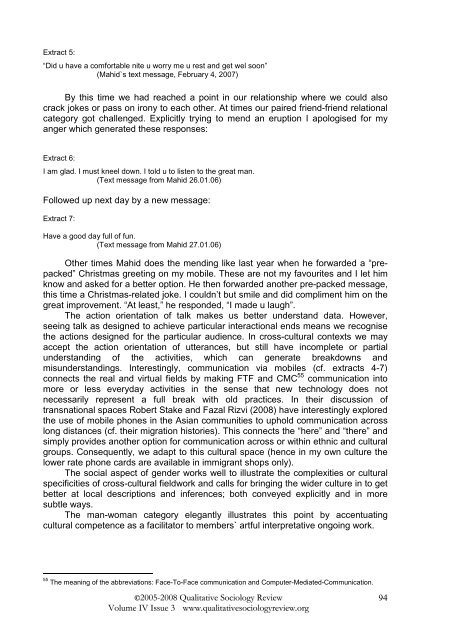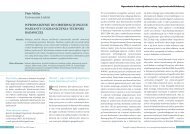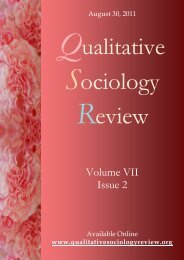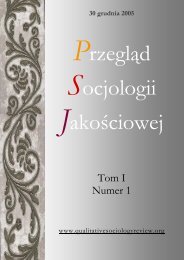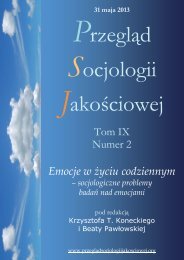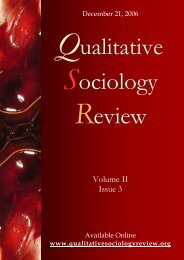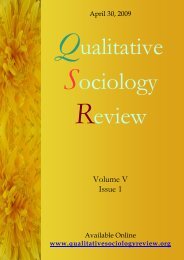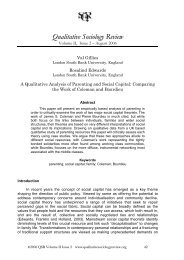volume IV is 3 - Qualitative Sociology Review
volume IV is 3 - Qualitative Sociology Review
volume IV is 3 - Qualitative Sociology Review
You also want an ePaper? Increase the reach of your titles
YUMPU automatically turns print PDFs into web optimized ePapers that Google loves.
Extract 5:<br />
“Did u have a comfortable nite u worry me u rest and get wel soon”<br />
(Mahid`s text message, February 4, 2007)<br />
By th<strong>is</strong> time we had reached a point in our relationship where we could also<br />
crack jokes or pass on irony to each other. At times our paired friend-friend relational<br />
category got challenged. Explicitly trying to mend an eruption I apolog<strong>is</strong>ed for my<br />
anger which generated these responses:<br />
Extract 6:<br />
I am glad. I must kneel down. I told u to l<strong>is</strong>ten to the great man.<br />
(Text message from Mahid 26.01.06)<br />
Followed up next day by a new message:<br />
Extract 7:<br />
Have a good day full of fun.<br />
(Text message from Mahid 27.01.06)<br />
Other times Mahid does the mending like last year when he forwarded a “prepacked”<br />
Chr<strong>is</strong>tmas greeting on my mobile. These are not my favourites and I let him<br />
know and asked for a better option. He then forwarded another pre-packed message,<br />
th<strong>is</strong> time a Chr<strong>is</strong>tmas-related joke. I couldn’t but smile and did compliment him on the<br />
great improvement. “At least,” he responded, “I made u laugh”.<br />
The action orientation of talk makes us better understand data. However,<br />
seeing talk as designed to achieve particular interactional ends means we recogn<strong>is</strong>e<br />
the actions designed for the particular audience. In cross-cultural contexts we may<br />
accept the action orientation of utterances, but still have incomplete or partial<br />
understanding of the activities, which can generate breakdowns and<br />
m<strong>is</strong>understandings. Interestingly, communication via mobiles (cf. extracts 4-7)<br />
connects the real and virtual fields by making FTF and CMC 55 communication into<br />
more or less everyday activities in the sense that new technology does not<br />
necessarily represent a full break with old practices. In their d<strong>is</strong>cussion of<br />
transnational spaces Robert Stake and Fazal Rizvi (2008) have interestingly explored<br />
the use of mobile phones in the Asian communities to uphold communication across<br />
long d<strong>is</strong>tances (cf. their migration h<strong>is</strong>tories). Th<strong>is</strong> connects the “here” and “there” and<br />
simply provides another option for communication across or within ethnic and cultural<br />
groups. Consequently, we adapt to th<strong>is</strong> cultural space (hence in my own culture the<br />
lower rate phone cards are available in immigrant shops only).<br />
The social aspect of gender works well to illustrate the complexities or cultural<br />
specificities of cross-cultural fieldwork and calls for bringing the wider culture in to get<br />
better at local descriptions and inferences; both conveyed explicitly and in more<br />
subtle ways.<br />
The man-woman category elegantly illustrates th<strong>is</strong> point by accentuating<br />
cultural competence as a facilitator to members` artful interpretative ongoing work.<br />
55 The meaning of the abbreviations: Face-To-Face communication and Computer-Mediated-Communication.<br />
©2005-2008 <strong>Qualitative</strong> <strong>Sociology</strong> <strong>Review</strong><br />
Volume <strong>IV</strong> Issue 3 www.qualitativesociologyreview.org<br />
94


